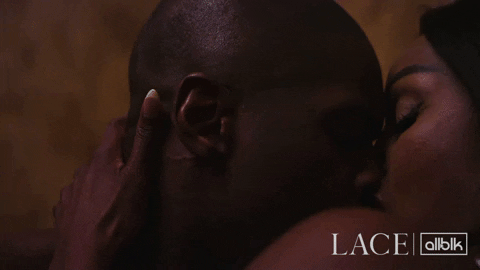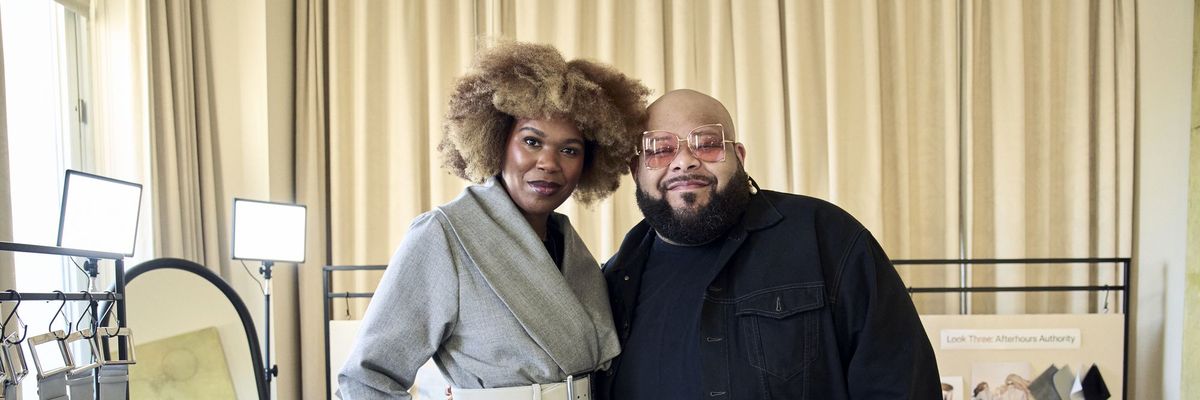
I think we all can agree that social media really is a double-edged sword. What I mean by that is there is just as much bad that can come out of it as good. At the end of the day, it really is about 1) having your own mind, 2) finding balance when it comes to how much time you spend online, and 3) doing your own research instead of taking random people’s opinions as the gospel (i.e., facts).
Gee, I wish more folks did all of this when it comes to if a man needs to have a large penis to sexually satisfy a woman (he does not) and if a woman who has had multiple sex partners will ultimately end up with a vagina that is too large for smaller penises to please her (a lie).
Science totally has my back on debunking both of those things (more on that in a bit). Know what else does? A particular type of sex method that is becoming more popular by the day. One that just might convince you to, as they used to say back in the day, focus less on the “size of the wave” and ride out the “motion of the ocean” instead.
It’s called shallowing. Here’s what it’s all about.
What Is Shallowing?
 Giphy
GiphyIf there’s one thing that I wish folks would say more thoroughly when it comes to women and orgasms, it’s that when it comes to 75 percent of women not being able to orgasm from only intercourse, the accurate statement is they struggle with achieving a vaginal orgasm without the assistance of some type of clitoral stimulation. Yeah, we’ve really got to remember that very few things in this life are a complete monolith — orgasms included (check out “U-Spot Orgasm, Fantasy Orgasm & 6 Other Orgasms You Should Try Tonight”).
In fact, it was while I was reading up on pairing — a word that is used for when clitoral stimulation transpires during penetration — that I decided to do some deep-diving into shallowing (because it was mentioned in one of the articles that I read). And what is it? Shallowing is when a penis, finger, tongue, or sex toy of some sort is used in order to ever so slightly penetrate the vaginal opening of a woman.
And why is shallowing not just a current sex trend but something that every woman on this planet should try? It’s because of what I’ve said, more than once, on this platform: it focuses on the most sensitive part of a woman’s vagina, which is the first two inches of her vaginal opening.
When the emphasis is placed there, not only does it increase your chances of experiencing “the big O,” but it can also build up anticipation, which can intensify your orgasms too — yes, shallowing can also be seen as a form of edging.
Another thing that’s cool about shallowing is — and it really and truly can’t be said enough — something that makes vaginal and blended orgasms easier to achieve for some women really has little to do with the size of a man’s package or even his technique; it’s straight up anatomy. Yep, the closer that a woman’s clitoris is to her vaginal opening, the easier it is for a penis to stimulate both. So, science makes it possible for vaginal orgasms to be easier for some women than others.
At the same time, shallowing can make it possible for more women who want to see what a vaginal orgasm actually feels like (because it’s easier for the head of the penis to stimulate the opening of the vagina while the shaft can rub up against your clitoris; based on the position that you are in, of course — the missionary with some pillows propped under the lower part of your back is ideal for this).
Now that you see what shallowing actually is, do you get why I said that penis size doesn’t matter when it comes to doing it — and getting the kind of orgasms that you want? Contrary to popular belief, your vagina is only around four inches. In fact, some health experts say that it ranges between 2-4”. Anything larger, your body literally has to stretch out to accommodate; this includes penises and babies. So, if your vagina is “making room” for more than four inches, why in the world do you think you need a 10-inch man? Yeah…exactly. It really is time to get over the silliness. The average penis continues to be 5.5”. Makes sense when you take it all in (no pun intended).
Aight, so now that you know what shallowing is all about, let me try and hard sell you on why it’s a sex technique that you should try as soon as tonight (if you possibly can).
1. It takes the pressure off of you and your partner.
I’ve been working with couples for almost 20 years at this point. This means that the topic of sex comes up quite a bit. And if there’s one thing that continues to be an issue is inconsistent orgasms (check out “Why Do Orgasms So Often Seem Like A ‘Hit-Or-Miss’ Experience For Women?”).
Listen, no matter how many articles you read or sex positions you try, if you’re anxious, stressed out, or overthinking, it’s gonna get in the way of you experiencing high peaks of pleasure on a consistent basis. Since shallowing is something that can easily be done even in foreplay (via fingering and/or oral sex) if you get that first “release” off, that makes it easier to just sit back and enjoy the ones that (hopefully) are to follow.
2. It teaches you more about your vagina.
A part of the reason why I keep repeating certain facts about vaginas in these articles is that it’s amazing how little certain things are discussed en masse — like the size of the vaginal tube. And since shallowing helps you to stimulate the nerve endings at the entrance of your va-jay-jay along with your G-spot (which is housed a little ways from your opening), shallowing is a great way to explore that area of your body as you figure out what truly works for you and…what doesn’t.
3. It’s the perfect merging of foreplay and intercourse.
When you really stop to think about it, shallowing is like the bridge between foreplay and intercourse because you can use so many different things to do it. So, if you want to experiment with a new sex toy or you want a bit more time to “warm up the engine” before full-on penetration begins, shallowing is one of the most sexually arousing compromises there is.
4. It can help to increase your partner’s stamina.
A few years back, I penned an article for the site entitled, “We’ve Got Some All-Natural Ways To Increase Stamina & Sensitivity.” Listen, even though I once read a GQ article that said that over 60 percent of the people they polled were fine with intercourse lasting no longer than 5-10 minutes — that poll doesn’t speak for all of us, chile.
So, if you would like your man to build up to going longer, shallowing can help to make that happen. Since he’s barely putting beyond the tip in, he can learn how to be in you for longer periods of time without being, well, in you.
5. It helps you to appreciate whatever “package” he has.
Again — and it really can’t be said enough — if shallowing is all about exploring the mere entrance of your vagina, you don’t need a man with BDE (check out “BDE: Please Let The 'It Needs To Be Huge' Myth Go”) or honestly, even anything close to it.
I mean, even though, reportedly, the size that the average woman says gives her the most orgasms is eight inches — I bet those women have never really tried shallowing before. 10”, 8”, or the average 5.5” can certainly get the job done. And well.
6. It feels A-MAZ-ING.
Okay, so now that you know about shallowing, I promise that if you put the word into your favorite search engine, you’re either gonna see articles on golfing (LOL) or sex, especially as of late. That’s because more couples are trying it out and getting mind-blowing results from it. So, if you’re looking for something new to try, give shallowing a shot.
Hey, anything that’s designed to stimulate your most intense vaginal nerve endings has got to be something for the record books. I mean, how could it not be? Lawd.
Let’s make things inbox official! Sign up for the xoNecole newsletter for daily love, wellness, career, and exclusive content delivered straight to your inbox.
Featured image by Juan Moyano/Getty Images
This Is How To Keep 'Holiday Season Stress' From Infecting Your Relationship
Hmph. Maybe it’s just me, but it seems like there is something really weird happening in the fall season air (because winter doesn’t officially begin until December 21) that cuddle season is in full swing while break-up season is as well. In fact, did you know that break-ups are so popular during the holiday season that December 11 is deemed Break-Up Day?
The reasons why relationships shift around this time vary; however, I did both roll my eyes and chuckle when I read that a very popular one is because it’s an easy way to get out of getting one’s significant other a Christmas present. SMDH.
Anyway, I personally think that the less shallow folks out here may contemplate calling things “quits” or they at least distance themselves a bit from their partner (and what I’m referring to is serious relationships) due to all of the stress and strain that oftentimes comes with the holidays whether it be financial, familial, due to their tight schedules or something else.
Listen, I would hate for you and your man to miss the fun and happiness of experiencing this time of year, all because you are so overwhelmed or irritated that you can’t really enjoy it. That’s why I have a few practical tips for how to avoid allowing the typical holiday season stress from INFECTING your relationship.
Manage Your Expectations
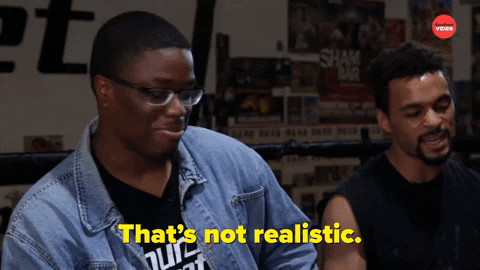 Giphy
GiphyUnmanaged expectations. If there is a main reason why the holiday season tends to be so stress-filled for so many people, I’d bet good money that this is the cause. And when you’re in a long-term relationship, expectations can manifest themselves in all sorts of cryptic and/or unexpected ways. You might have relatives who assume that you are going to be with them for Thanksgiving or Christmas when you have other plans in mind. You might be thinking that you are going to spend one amount for presents while your man is thinking something totally different. When it comes to scheduling, your signals may be crossed.
And you know what? To all of these scenarios, this is where clear and consistent communication come in. Don’t assume anything. Don’t dictate anything either. From now until New Year’s, mutually decide to check in once a week, just to make sure that you are both on the same page as it relates to the holidays and what you both are thinking will come along with it. The less blindsided you both feel, the less stressed out you will be. Trust me on this.
Set (and Keep) a Budget
 Giphy
GiphyOkay, so I read that last year, 36 percent of Americans incurred some type of holiday-related debt. Hmph. Last year, there was still some sense of normalcy in this country, chile, so I can only imagine what finances are gonna look like over the next several weeks. That said, since I don’t know a lot of people who don’t find being broke stressful, make sure that you and your bae set a budget and then stick to it this year — no ifs, ands or buts.
Because really, y’all — it doesn’t make sense to deplete savings and/or max out credit cards for a few days of giggles only to be damn near losing your mind because you don’t know how to make ends meet come Dr. Martin Luther King, Jr. Day.
And by the way, this tip doesn’t just speak to things like food and gifts; I also mean travel. If it doesn’t make a ton of sense (or cents) to be all over the place this year — DON’T BE.
Keep Matthew 5:37 at the Forefront
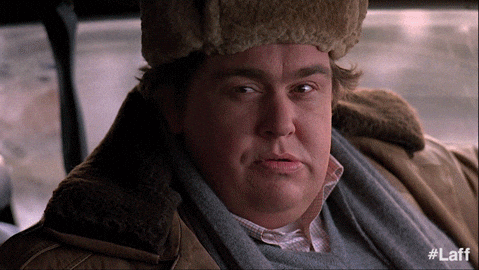 Giphy
GiphyIf off the top of your head, you don’t know what Matthew 5:37 says, no worries, here ya go: “But let your ‘Yes’ be ‘Yes,’ and your ‘No,’ ‘No.’ For whatever is more than these is from the evil one.” That verse right there? Oh, it’s a boundaries lifesaver! I say that because do you see “maybe” or “I’ll think about it” in there? Nope. LOL. It says that you should tell people “yes” or “no” and leave it at that — and that complements Anne Lamott’s quote, “’No’ is a complete sentence” impeccably well. Yeah, you’ve got to remember that anything beyond a yes or no to a request is privileged information; you don’t owe anyone details or an explanation.
Besides, if you are really honest with yourself, when someone asks you something and you give a “Umm, let me think about it” kind of reply, more times than not, you already know what your answer is going to be — so why not let you both off of the hook? Give your response. Commit to that. And let everyone (including yourself) get on with their lives and schedules.
I promise you that when it comes to those holiday parties, you are pissing more folks off by not RSVP’ing or doing so and not showing up than just saying, “Thank you but not this year” off the rip.
Remember That Your Personal Space Is Privilege Not a Right
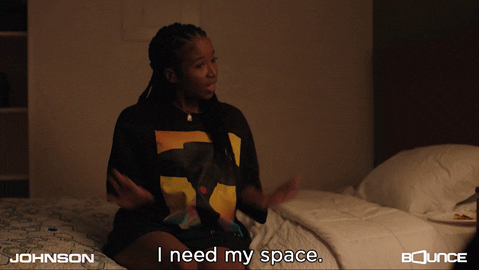 Giphy
GiphyA friend of mine recently bought a new house and invited me over to come see it. He’s a single man with no children, so as I was taking in all of the space that he had, especially as I walked through his finished basement, I joked about relatives coming to live with him. “Hell no” and “absolutely not” were pretty much his immediate responses as he went on to say that some folks even had the nerve to be offended when he told them that he had no intentions on taking DNA in.
Ain’t it wild how people think that your stuff is their right? And yes, that brings me to my next point. Your home is your sanctuary space. If you want to host folks this year — cool. If not, ALSO COOL. Please don’t let folks (family included) guilt you into how they want you to act or even into what they would do if the shoe was on the other foot. You are not them — and as one of my favorite quotes states, “If two people were exactly alike, one of them would be unnecessary.” (A man by the name Larry Dixon said that.)
Hell, my friends? They know that I am good for sending them random things that they need or even want all throughout the year. Coming over to hang out at my pace, though. Uh-uh. Chalk it up to being a card-carrying member of the ambivert club yet I like keeping my living space personal — and I sleep like a baby, each and every night, for feeling that way.
Always remember that your space, your time, your resources, your energy and shoot, yourself period (including your relationship), are all things that are your own. You get to choose how, when and why you want to share them. The holiday season is certainly no exception.
Cultivate Some “You Two Only” Traditions
 Giphy
GiphyIt’s not uncommon for some couples to hit me up after the holiday season to “detox.” Sometimes it’s due to the financial drama (and sometimes trauma) that they experienced. Sometimes it’s because they allowed their relatives (especially in-laws) to get more into their personal business than they should’ve. More than anything, though, it tends to be because they didn’t get enough quality time together and so ended up feeling “disconnected.”
Please don’t let that happen. Listen, I’m not even a holidays kind of woman and yet, I will absolutely sit myself down with some hot chocolate and chocolate chip cookies to enjoy a Hallmark holiday film or two. Aside from the fact that most of them are lighthearted and sweet, I also like that they usually focus on couples loving on each other amidst all of the holiday beauty and ambiance — which is something that all couples should set aside some time to do.
Maybe it’s a vacation. Maybe it’s a staycation. Or maybe it’s my personal favorite, A SEXCATION. Whether it’s for a few days, the weekend or even overnight — don’t you let the holidays go by without setting aside time for you and your man to celebrate one another. Don’t you dare (check out “Are You Ready To Have Some Very Merry 'Christmas Sex'?”).
GET. SOME. REST.
 Giphy
GiphyI once read that 8 out of 10 people get stressed out over the holidays and 3 out of 10 lose sleep during to it — and when you’re stress-filled and sleep-deprived, that can absolutely lead to hypersensitivity, making mountains out of molehills and even not being in the mood for sex.
Your relationship can’t afford to go through any of this, so definitely make sure to prioritize rest. I don’t care how unrealistic it might seem during this time, sleep should never be seen as a luxury; it will always and forever be a great necessity.
That said, try to get no less than six hours of shut-eye in (check out “6 Fascinating Ways Sex And Sleep Definitely Go Hand In Hand”) and even ask your bae to take a nap with you sometimes (check out “Wanna Have Some Next-Level Sex? Take A Nap, Sis.”). Not only will sleep help to restore your mind, body and spirit but, when it’s with your partner, it’s an act of intimacy that can make you both feel super connected, even in the midst of what might feel like chaos.
___
Holiday season stress is real. Still, never give it the permission or power to throw your relationship off. Put you and your man first and let the holidays be what they are gonna be, chile.
Let’s make things inbox official! Sign up for the xoNecole newsletter for love, wellness, career, and exclusive content delivered straight to your inbox.
Featured image by Shutterstock
Sergio Hudson On Designing With Intention And Who Gets Left Out Of The Industry
Sergio Hudson dreamt big as a young South Carolina boy staring out of the window of his mom’s Volvo driving down the Ridgeway, South Carolina streets. Those dreams led him to design opulent tailoring that’s been worn by Beyoncé, Queen Latifah, former Vice President Kamala Harris and Forever First Lady Michelle Obama, just to name a few.
Those dreams have come full circle in a new way as he recently collaborated with Volvo for a mini capsule collection suitable for chic and stylish moments this fall. The 40-year-old designer follows a long legacy of fashion aficionados who’ve used their innovation to push the automotive industry forward, including Virgil Abloh, Eddie Bauer, Paul Smith and Jeremy Scott.
Using the same material from the interior of the Volvo EX90, Hudson crafted a wool-blend car coat and waistbelt that combine the vehicle’s Scandinavian design with his signature tailoring and intention. The exclusive collection launched on October 20, and each piece is made-to-order by Sergio Hudson Collections.

Courtesy
In October, I traveled to Charleston with a group of journalists to get a firsthand look at Hudson and Volvo’s location. During a fitting, Hudson said his goal is to make “great work that can stand the test of time.”
“People can look back on and say, ‘I remember when Sergio did that collaboration with Volvo,’” he continued. “Thinking about aligning yourself with classic brands that speak to where you want to go. And I think that's what this collaboration kind of means to me and my business.”
Hudson pinpoints his mom as the biggest influence for his designs. This collaboration was no different.
“This particular coat reminded me of the swing coats that my mom used to wear in the early 90s. You know, diva girls in the early 90s had Sandra suits,” he said, referring to Jackée Harry’s character in 227. “My mom wore those and she would have these matching swing coats to go over them. And that's where the initial idea came. This would be around the same time that we had our Volvo. So she would put on her suit, her swing coat, get in that red Volvo, and go to church.”
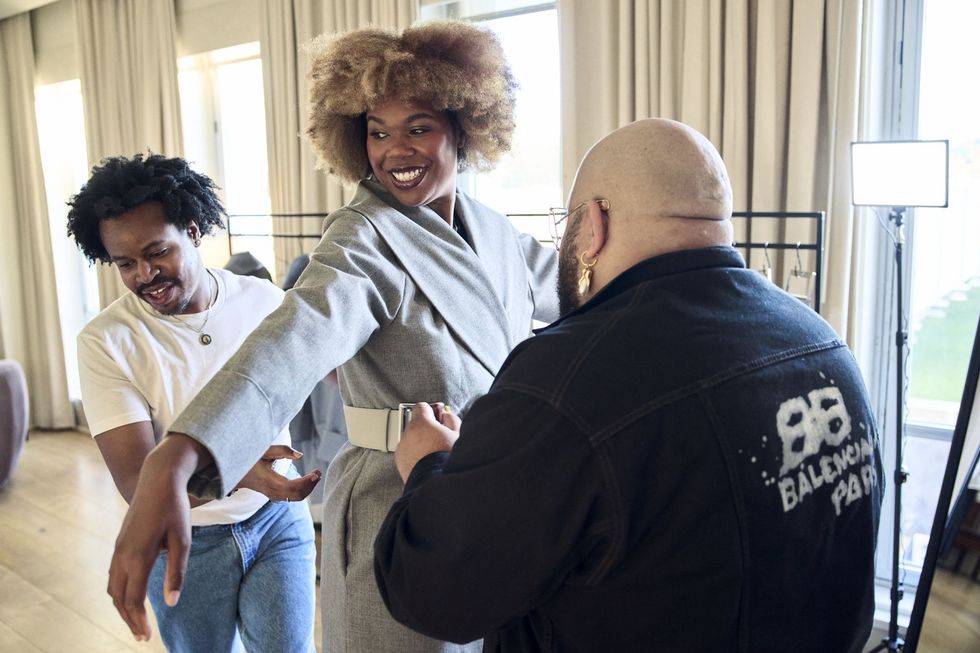
Courtesy
With this capsule and beyond, Hudson wants to see more staples rotating in and out of closets this fall. He advises fashionistas to build her closet out with essentials to mix and match that aren’t just stylish but also sustainable.
“It's just those special pieces,” he said. “You can wear the same shirt and pants every day and nobody will notice. But if you have a special boot, a special coat, a special bill, a special bag, that kind of speaks to everything that your style stands about, that is something you should focus on.”
These are the same kind of staple pieces that return to our Pinterest boards and TikTok feeds season after season. Fast fashion has never been Hudson’s aim. “I'm trying to create a special pieces that can stand the test of time,” he said in his warm, Southern accent. “I'm only creating those kind of pieces from here on out.”
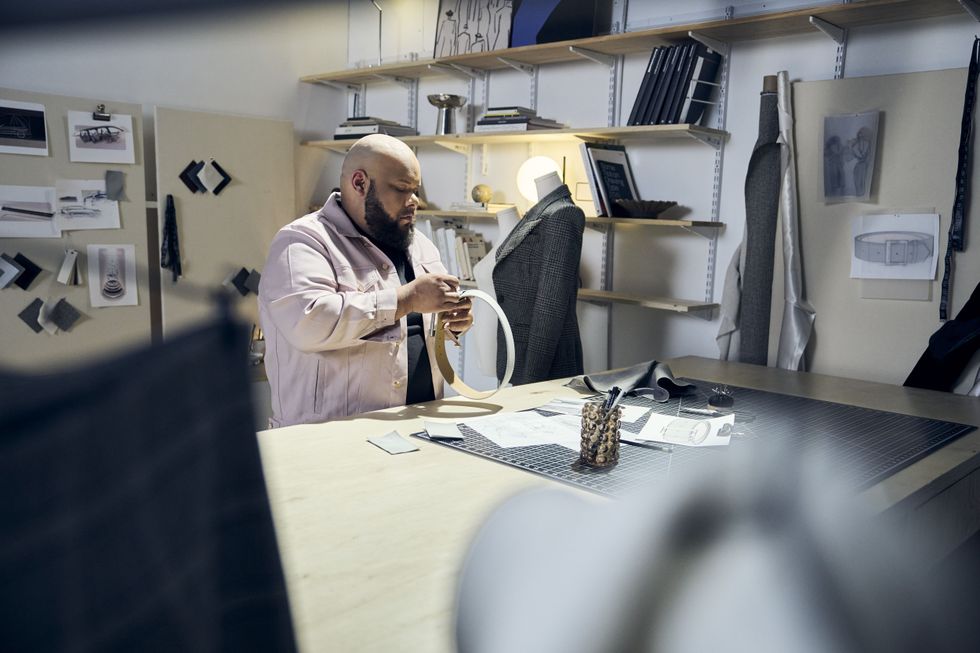
Courtesy
For Hudson, this collaboration is revolutionary. It’s his first time working with a car company and experimenting outside of his wheelhouse in this way.
“This is a Scandinavian brand, and, you know, it's 70 years old. I'm an African-American boy from South Carolina that has had a brand for 10 years. So I think bridging those two worlds and seeing the similarities was the beauty of this project,” he explained.
Though Hudson and his partner and CEO of Sergio Hudson Collections Inga Beckham have made massive strides in just 10 years, Hudson said the industry is far from where he wants to see it when it comes to Black representation. He pointed to how few Black designers were at this year’s Met Gala despite the theme being Black dandyism.
“The fact that I dressed 18 people speaks to how many of us weren't there,” he said. He implored more of industries, fashion and beyond, to collaborate with Black designers often.
“Allow mentorship. Allow funding. Allow great design to shine through,” he implored. “When it comes to being a designer of African descent, when you can't get the funding that your counterparts have, you can't compete. When you get opportunities like doing a collaboration with Volvo, or you get opportunities to be at the Met Gala, that's putting us on the equal playing field, but really the funding behind it is what we need to take it to that desk level.”
Featured image courtesy



